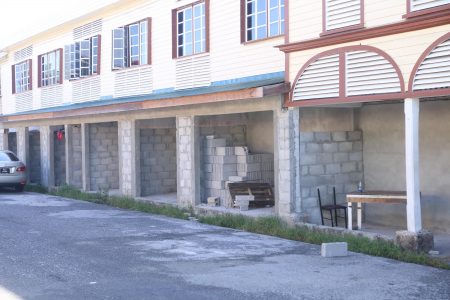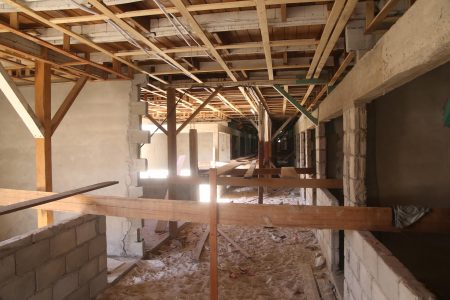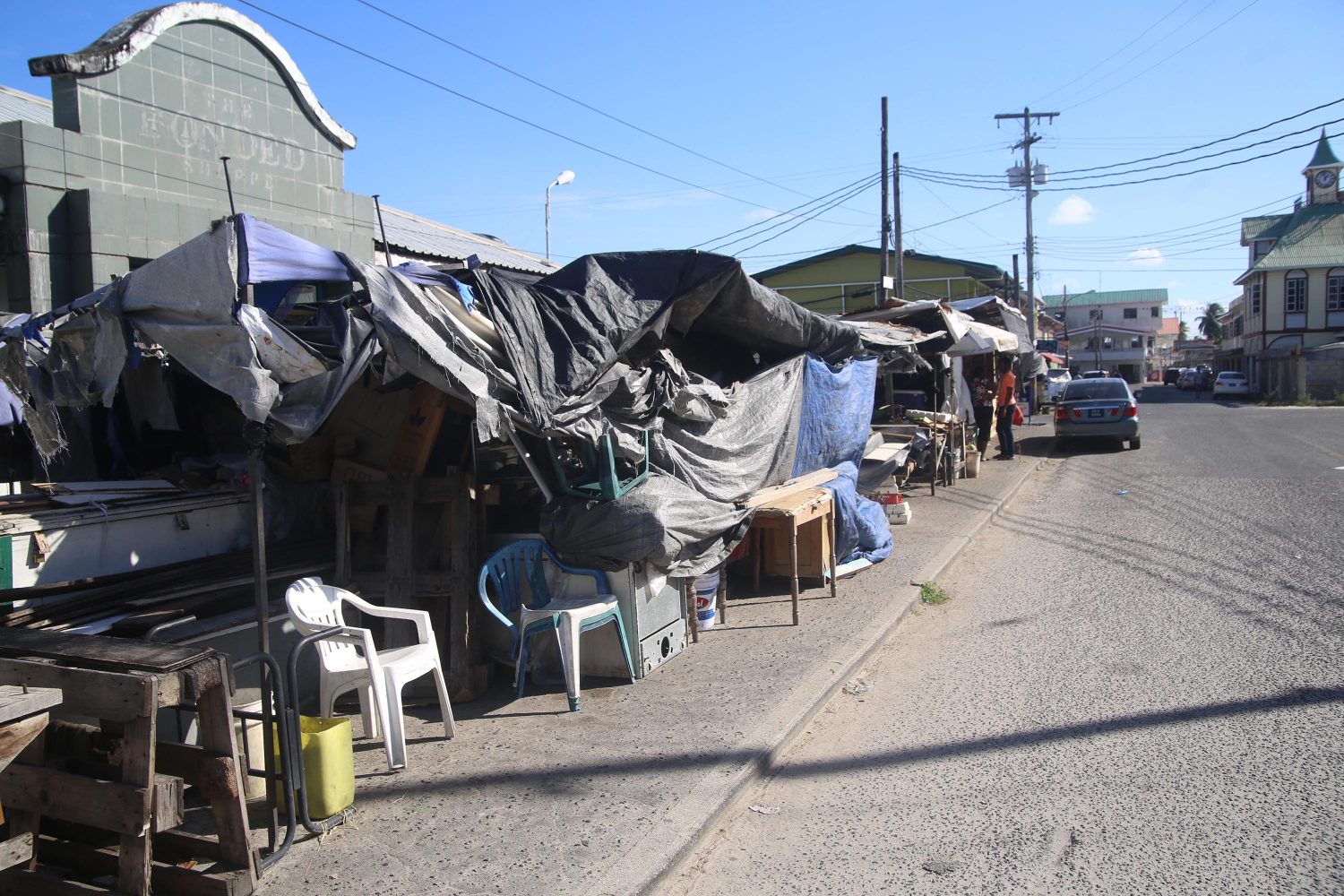With 20 months having elapsed since the commencement of rehabilitative works on the Kitty Market, vendors have grown pessimistic about the market’s completion.
Some related yesterday that they are unaware of how and when the project is expected to progress since they have not had any recent discourse with City Hall, and it has been months since any work has been done. Some do not believe the market will be completed before the end of this year.
Only a few were out around midday yesterday when Sunday Stabroek visited the area. Because vendors have been displaced, forced to take up occupancy on the pavements outside of the market, they have also been forced to adapt to their new conditions, including working in tandem with the sun.
When Sunday Stabroek arrived, one vendor had begun packing up his stall for a sabbatical until around 5pm, when he would resume his trade. He related that the heat affected their trading hours, since they were now outside and exposed to the elements.
“We do far better business in deh. Because time like now we gotta close…we gotta put tarpaulin in front here and cover down…the sun affecting your sales…you can’t bring out nice things to put out here, the sun damaging them,” the vendor stated.
It was related that for this reason many vendors have taken to only selling in the morning or late afternoon hours.

“We used to do business more in there…because the market isn’t finished that’s why we not getting much business. Cause people seeing that the market is under repairs so they feel that it’s not functioning, nobody not in here,” another said.
The woman, a clothes vendor, related that she has to place clothes outside so potential patrons know that there are persons selling in their location, at the side of the market.
“Basically, me and she more does deh at the market. The rest of people not coming because business ain’t doing and the condition of the market mek people don’t really come…they still paying they rent though, everybody still paying stall rent as normal,” she added.

She related that many of the vendors who once took up occupancy at the side of the market have resorted to only vending on the weekends because of how slow business is, although they still pay rent.
She raised another issue, however, which is the extra time that has to be spent every day to pack and unpack the clothes, since they are no longer in a secure location.
“It really hard for us out here, because packing these things is take me one and a half hour every morning. It don’t be easy, and then you coming, not selling because the market like this, I mean you’re losing business,” she said.
Permanent structure
When work began on the Kitty Market in February, 2016, it was estimated that it would be completed within three to five months.
It has been 20 months since, and at least one vendor reached the point at which she felt the need to expend resources to develop a more permanent structure as a security measure.
“If when they was doing the market there and Mr King had said to us, now listen, we gon take two years or we’re gonna take three years—you know how much material waste from that market? We
coulda take those material that waste there and make proper, decent stands until they
finish and ready for us. Because if you look down the line here, this is the only decent stand that you’re seeing,” she stated.
The woman said she has spent approximately $200,000 rebuilding her stall, enclosing it and having shutters installed. It had been broken into several times before and the security placed by the council only guards the marketplace.
“Wah I had to do recently, I had to restructure my stand for security because for so long I’m here. Because when we come over here, they tell us three months—well we know work couldn’t have finished in three months. Then from three months they say Christmas last year…It’s 20 months we’re out here and they never look back for us.”
In her opinion, business outside the physical marketplace isn’t any better or any worse, as she said the economy on the whole seems to have taken a blow. She did, however, criticise the design of the structure, and questioned under whose advice the Council had decided to make such a decision.
“Those concrete structure there that the council put up, I don’t know who give them that idea because if you take a look at those stands, this here that I’m selling here, this is perishables, it needs air. This concrete—when the concrete hold that heat and I lock it up in the night and I gone home, next morning when I come back, wah you think gon happen to my greens dem in deh? I goh tek all next morning and dump them? ‘Cause that’s like a furnace,” she said.
“Look how that building is low already and then you gon put concrete right up to the top?” the woman questioned, alluding to the high electricity rates that will come as a result.
“Them concrete thing wah they putting in front deh that’s not for we wah selling greens and provision, that look like fuh people waz sell sugar cake and fudge and plantain chip, that’s wah they mek deh fuh. That’s wah we economy gone to? Because them stalls look like fudge and sugar cake and plantain chip and black pudding. Them ain’ look for greens vendor like we,” she strongly stated, making reference to the recent calls for and rise in the manufacture of agro-processed products.
In February of this year, Mayor Patricia Chase-Green announced that work on the Kitty Market has been placed on hold once again because of the lack of financial resources.
She had gone on to say that she would not give a deadline for the completion of the market, since work would only resume when revenue is generated.
Stabroek News had last reported that 70 per cent of phase 1 of the project has been completed and the 30% remaining included the installation of electrical wiring, air conditioning units, and other works.
It was reported in February that $90 million has been expended on the building. A sum of $240 million was the total restoration estimate.





